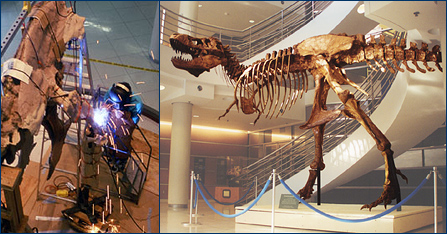
UCMP's T. rex
 |
A three-day celebration, September, 15–17, 1995, marked the official unveiling of UCMP's free-standing mounted skeleton of Tyrannosaurus rex in the Valley Life Science Building's Wallace Atrium. The "T. rex Expo" introduced the public to (1) the T. rex, (2) the Museum's new quarters in VLSB and (3) the research being done at UCMP. But the primary purpose was to thank all the donors who graciously supported the construction of this exciting acquisition.
The UCMP T. rex is a cast of a skeleton found by rancher Kathy Wankel on the shores of Fort Peck Lake in Montana in 1988. Matt Smith of Livingston, Montana, did the molding and casting of the bones.
Building a free-standing mount of a 40-foot skeleton wasn't easy. The skeleton had to fit inside a circular stairwell 20 feet across and had to be braced with an internal steel armature to guard against the earthquakes that northern California has been known to experience. It also had to be as biologically accurate as possible; an active pose was desired. A team of museum scientists and students, along with sculptors from Industrial Light and Magic, fulfilled all of these conditions with flair.
Click on any of the "slides" below to see how it was all accomplished. Also, see some dino art done by K-5 children in the Berkeley area, entries in a contest that was part of the "T. rex Expo," or learn more about the Tyrannosauridae.
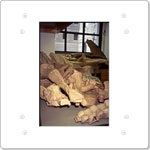 |
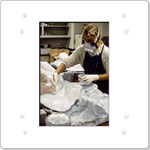 |
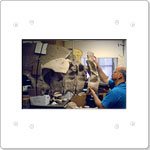 |
|
The cast of the T. rex skeleton was shipped to us in a twelve-foot wooden crate. The 300-odd bones were unpacked and moved to the Prep Lab. Here you can get an idea of what the cast bones looked like "right out of the box." |
Each cast of each bone had to be washed, tooled, and painted by hand, a job for the entire crew. Here, UC undergraduate Tina Athena Trakadas applies an undercoat to the sacrum and ilia. |
The skeleton's pose was worked out in the laboratory with a model before actual construction began. Each cast of the fossil was then cut and drilled to accommodate an internal framework of steel tubing. This was fabricated in the workshop and then assembled in place. In the Prep Lab, Bob Cooper of Industrial Light & Magic tests the dorsal vertebrae for fit. |
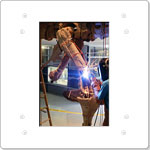 |
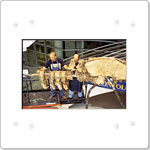 |
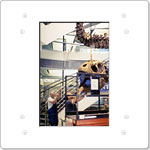 |
|
With the bones temporarily held in place with bungee cords, Mark Goodwin welds the steel frame. |
Bob Cooper and Mark Siegel, also of Industrial Light & Magic, prepare the dorsal vertebrae for final mounting on the frame. |
Bob Cooper and Mark Siegel lift the T. rex skull into position. |
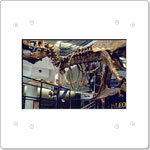 |
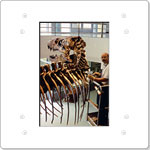 |
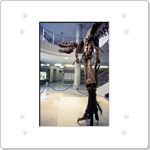 |
|
Mark Goodwin and Mark Songey (yes, there were three Marks working on this project!) in the process of attaching the ribs. |
Bob Cooper does some final touching up with the paint. |
Finished! Tyrannosaurus rex keeps watch over the Wallace Atrium of the Valley Life Sciences Building. |
Original T. rex Expo pages created by Ben Waggoner in 1995; other contributions to these pages by Rob Guralnick, Judy Scotchmoor, Dave Polly, Sergei Lavrov, Allen Collins, Greg Erickson, Tony Fiorillo, Anne Weil, Chris Bell, Mark Goodwin, Brian Speer and Pat Holroyd; modifications since 2000 by David Smith. "Slide" photos all by Mark Goodwin, © UCMP. Top T. rex skeleton photo by Dave Smith, © UCMP. Welding photo courtesy of Mark Goodwin(?), © UCMP.